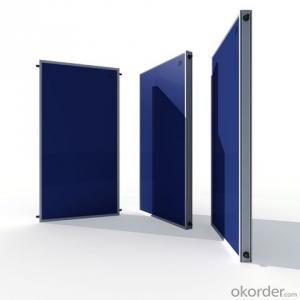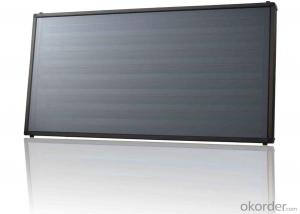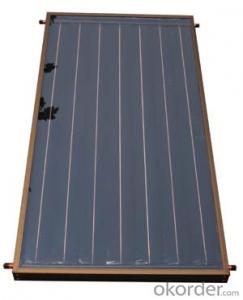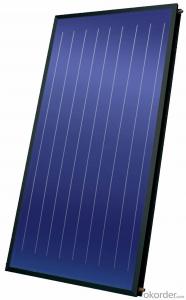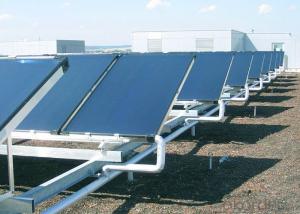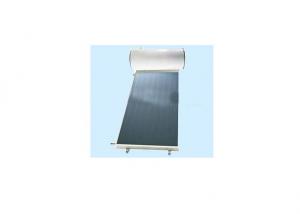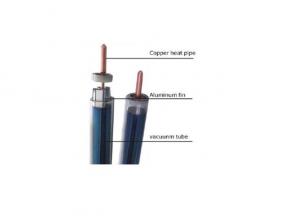Heat-pipes Solar Collectors for Rooftop made in China
- Loading Port:
- China main port
- Payment Terms:
- TT OR LC
- Min Order Qty:
- 5 set
- Supply Capability:
- 10000 set/month
OKorder Service Pledge
OKorder Financial Service
You Might Also Like
Specifications
manifold (inner) | red copper |
manifold (exterior) | aluminum alloy |
glass tube dimensions | 58mm * 1800mm |
daily efficiency | ≥55% |
heat preservation | 72 hours |
hail resistance | 25mm |
max pressure | 7 bar |
coating of vacuum tube | ALN/AIN-SS/CU |
heat pipe | anti-freezing > -35 degree |
certificate | Solar Keymark, EN12975,SRCC |
Serious Product
Models | L*W*H mm | Vacuum tube | Power output | Efficiency | Header mm | Frame | container loading 20FT/40HQ sets | Gross Weight kg |
SHC-8 | 1917*910*133 | 58*1800*8pcs | 939W | 0.668 | Φ35/1.0 | AL alloy | 185/445 | 27 |
SHC-10 | 1917*1130*133 | 58*1800*10pcs | 1189W | 159/385 | 33 | |||
SHC-12 | 1917*1350*133 | 58*1800*12pcs | 1440W | 149/358 | 40 | |||
SHC-15 | 1917*1680*133 | 58*1800*15pcs | 1815W | 120/290 | 49 | |||
SHC-18 | 1917*2010*133 | 58*1800*18pcs | 2191W | 100/242 | 59 | |||
SHC-20 | 1917*2230*133 | 58*1800*20pcs | 2442W | 87/210 | 66 | |||
SHC-22 | 1917*2450*133 | 58*1800*22pcs | 2692W | 83/202 | 72 | |||
SHC-24 | 1917*2670*133 | 58*1800*24pcs | 2943W | 77/188 | 79 |
Packaging & Delivery
Packaging Details: | Exporting Carton with big foaming protection |
Delivery Detail: | In 10-15 days |
Loading Quantity
Model | Tube | Tube Q.T.Y | Loading Q.T.Y/40HQ |
GSC15 | 58*1800mm | 15pcs | 315sets |
GSC18 | 58*1800mm | 18pcs | 265sets |
GSC20 | 58*1800mm | 20pcs | 248sets |
GSC22 | 58*1800mm | 22pcs | 225sets |
GSC25 | 58*1800mm | 25pcs | 200sets |
GSC30 | 58*1800mm | 30pcs | 168sets |
Principle of solar collector:
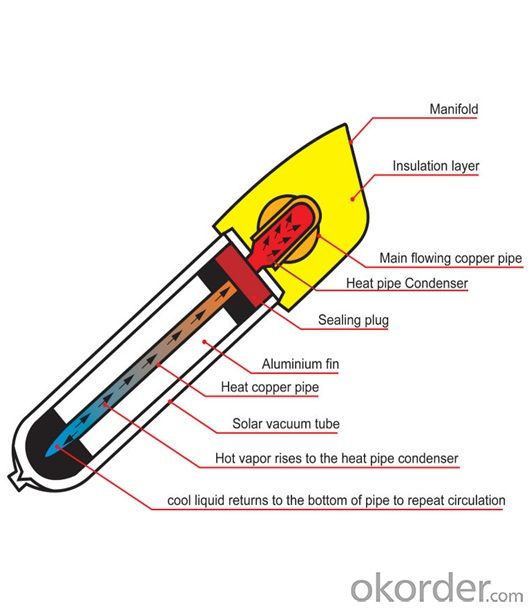

Solar collector details
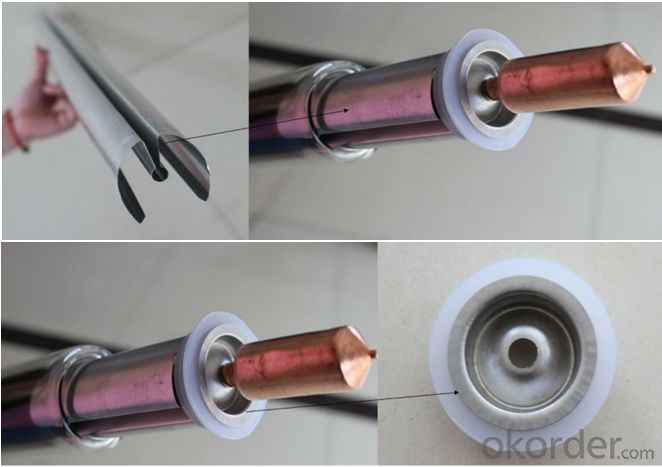

- Q:Can solar collectors be used for heating colleges?
- Yes, solar collectors can be used for heating colleges. Solar thermal systems, such as solar water heaters or solar air heaters, can efficiently capture and utilize the sun's energy to provide heating for college campuses. These systems can be integrated into the existing heating infrastructure, reducing the reliance on fossil fuels and decreasing carbon emissions. Additionally, solar collectors can be cost-effective in the long run, as they harness a renewable energy source and can significantly reduce energy costs for the college.
- Q:Can solar collectors be used for heating commercial buildings?
- Yes, solar collectors can be used for heating commercial buildings. Solar thermal collectors can capture the sun's heat and transfer it to a building's heating system, providing a renewable and sustainable source of heat. This can help reduce energy costs and carbon emissions associated with heating commercial buildings. Additionally, solar collectors can be integrated into existing heating systems or used as standalone systems, depending on the specific requirements of the building.
- Q:Can solar collectors be used for heating in areas with high pollution?
- Solar collectors can still be utilized for heating purposes in regions with high pollution. While pollution does have some impact on the efficiency of solar panels, they are still capable of producing a significant amount of heat. The primary reliance of solar collectors is on sunlight, and even in heavily polluted areas, there is still sunlight that manages to reach the Earth's surface. However, it should be noted that the level of pollution does influence the overall efficiency and effectiveness of the solar collectors. In areas with severe pollution, the amount of sunlight that reaches the panels may be diminished, resulting in a decrease in the heat produced. Furthermore, pollution can cause the panels to accumulate dust and dirt, which further hampers their efficiency. Therefore, regular cleaning and maintenance of the solar collectors are imperative to ensure optimal performance, particularly in areas with high pollution levels.
- Q:Can solar collectors be integrated into the design of a building?
- Yes, solar collectors can be integrated into the design of a building. They can be incorporated into the roof or façade of a building to capture sunlight and convert it into usable energy. This integration not only helps to generate renewable energy but also enhances the aesthetics and sustainability of the building.
- Q:Can solar collectors be integrated into building designs?
- Yes, solar collectors can be integrated into building designs. They can be installed on rooftops, facades, or integrated into windows, allowing buildings to generate clean, renewable energy while maintaining their aesthetic appeal. This integration not only reduces reliance on traditional energy sources but also maximizes the use of available space for sustainable energy production.
- Q:What is the size of a typical solar collector?
- The size of a typical solar collector can vary depending on its purpose and design, but most residential solar collectors are usually around 4 to 6 feet wide and 6 to 8 feet tall.
- Q:Are solar collectors suitable for schools and universities?
- Yes, solar collectors are suitable for schools and universities. Solar collectors, such as solar panels, are an environmentally-friendly and sustainable source of energy. Installing solar collectors in educational institutions like schools and universities can have numerous benefits. Firstly, solar collectors can help educational institutions reduce their carbon footprint and contribute to a greener future. By harnessing the power of the sun, schools and universities can generate clean energy, reducing their reliance on fossil fuels and decreasing greenhouse gas emissions. This aligns with the educational mission of these institutions, teaching students about renewable energy and sustainable practices. Secondly, solar collectors can lead to significant cost savings for schools and universities. Educational institutions typically have large energy demands, with numerous buildings and facilities requiring electricity. By installing solar collectors, these institutions can generate their own electricity, reducing their dependence on the grid and lowering their energy bills. Over time, the cost savings from using solar energy can be substantial, allowing schools and universities to allocate more resources to educational programs and initiatives. Moreover, solar collectors can serve as educational tools themselves. By incorporating solar energy systems into the curriculum, students can learn about renewable energy technology, energy efficiency, and the science behind solar power. This hands-on learning experience can enhance students' understanding of sustainable practices and inspire them to pursue careers in renewable energy or related fields. Additionally, solar collectors can act as a visual representation of an educational institution's commitment to sustainability. By showcasing their use of clean energy, schools and universities can inspire their students, staff, and surrounding community to adopt more environmentally-friendly practices. This can create a culture of sustainability within the institution and contribute to a positive image in the community. In conclusion, solar collectors are highly suitable for schools and universities. They provide a sustainable source of energy, reduce carbon emissions, and lead to significant cost savings. Moreover, they serve as educational tools and promote a culture of sustainability. By embracing solar energy, educational institutions can demonstrate their commitment to a greener future while providing valuable learning opportunities for their students.
- Q:Can solar collectors be used in solar thermal cooling?
- Solar thermal cooling systems have the ability to utilize solar collectors for their operation. These collectors, such as flat plate or evacuated tube collectors, capture the sun's radiation and convert it into heat energy. This heat energy can then be utilized to power a thermally-driven cooling system like an absorption or adsorption chiller. When implementing a solar thermal cooling system, the solar collectors are typically connected to a heat transfer fluid, which can be water or a specialized fluid. This fluid absorbs the heat from the sun and is subsequently employed to drive the cooling process in the chiller system. The chiller system, powered by the solar collectors, effectively cools the air or fluid utilized in the cooling system. The use of solar collectors in solar thermal cooling systems results in reduced or eliminated reliance on traditional electricity for cooling purposes. This leads to significant energy and cost savings. Moreover, solar thermal cooling systems have lower greenhouse gas emissions compared to conventional cooling systems, making them an environmentally friendly option. However, it is important to consider that solar thermal cooling systems may have limitations in terms of their cooling capacity. Additionally, they require sufficient sunlight to operate optimally. Factors such as system design, climate conditions, and energy storage solutions must also be taken into account to effectively utilize solar collectors in solar thermal cooling.
- Q:Are there any size limitations for solar collectors?
- There are no specific size limitations for solar collectors as they can vary in size depending on the specific application and available space. However, larger solar collectors generally have higher efficiency and can generate more energy.
- Q:Can solar collectors be used for heating swimming pools?
- Yes, solar collectors can be used for heating swimming pools.
1. Manufacturer Overview |
|
|---|---|
| Location | |
| Year Established | |
| Annual Output Value | |
| Main Markets | |
| Company Certifications | |
2. Manufacturer Certificates |
|
|---|---|
| a) Certification Name | |
| Range | |
| Reference | |
| Validity Period | |
3. Manufacturer Capability |
|
|---|---|
| a)Trade Capacity | |
| Nearest Port | |
| Export Percentage | |
| No.of Employees in Trade Department | |
| Language Spoken: | |
| b)Factory Information | |
| Factory Size: | |
| No. of Production Lines | |
| Contract Manufacturing | |
| Product Price Range | |
Send your message to us
Heat-pipes Solar Collectors for Rooftop made in China
- Loading Port:
- China main port
- Payment Terms:
- TT OR LC
- Min Order Qty:
- 5 set
- Supply Capability:
- 10000 set/month
OKorder Service Pledge
OKorder Financial Service
Similar products
New products
Hot products
Hot Searches
Related keywords













